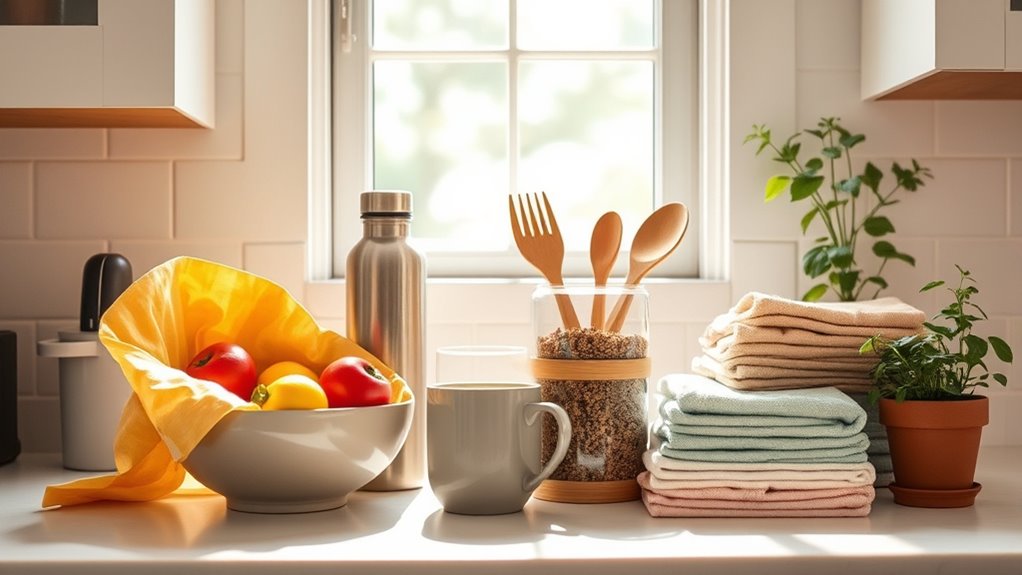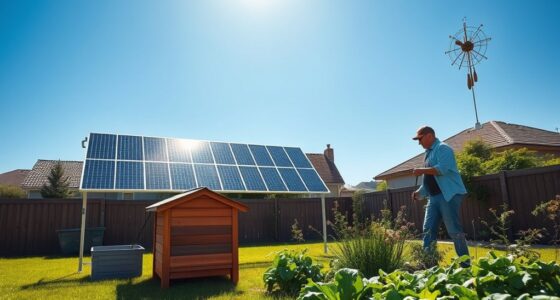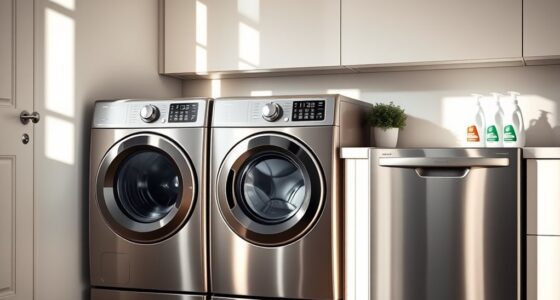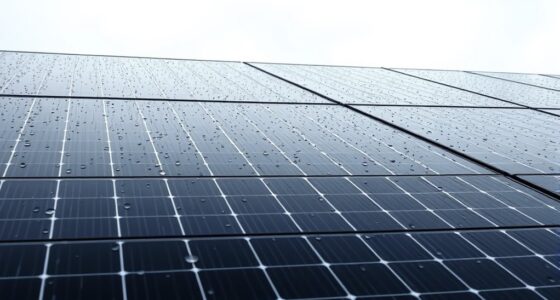Making five simple swaps at home can greatly cut your environmental impact. Switch to reusable bags and containers to reduce plastic waste, and upgrade to energy-efficient lighting and appliances to save power. Use eco-friendly cleaning products that break down naturally and install smart fixtures to conserve water. Ultimately, choose grocery packaging that’s minimal or biodegradable to lessen waste. Keep exploring how these small changes can lead to big eco-friendly benefits.
Key Takeaways
- Switch to reusable cloth or mesh bags and containers for shopping and storage.
- Replace traditional bulbs with LED energy-efficient lighting and upgrade to Energy Star appliances.
- Use biodegradable, eco-friendly cleaning products to minimize chemical impact.
- Install water-saving fixtures like smart showerheads and leak detectors to reduce water consumption.
- Choose products with minimal, biodegradable packaging and buy in bulk to cut down on waste.
Switch to Reusable Bags and Containers

Have you ever thought about how much waste comes from single-use bags and containers? Every time you use plastic bags or disposable containers, you’re contributing to environmental pollution. Switching to reusable containers is a simple yet impactful change. Instead of grabbing a plastic bag at the store, bring your own cloth or mesh bags. For food storage, opt for durable, reusable containers made from glass or BPA-free plastic. These containers reduce waste and often keep food fresher longer. Using reusable options can also help you avoid the harmful chemicals sometimes found in plastic containers. Not only do reusable bags and containers cut down on landfill waste, but they also save you money over time. Small daily choices like this add up, making a noticeable difference in reducing plastic pollution and promoting a healthier planet.
Opt for Energy-Efficient Lighting and Appliances
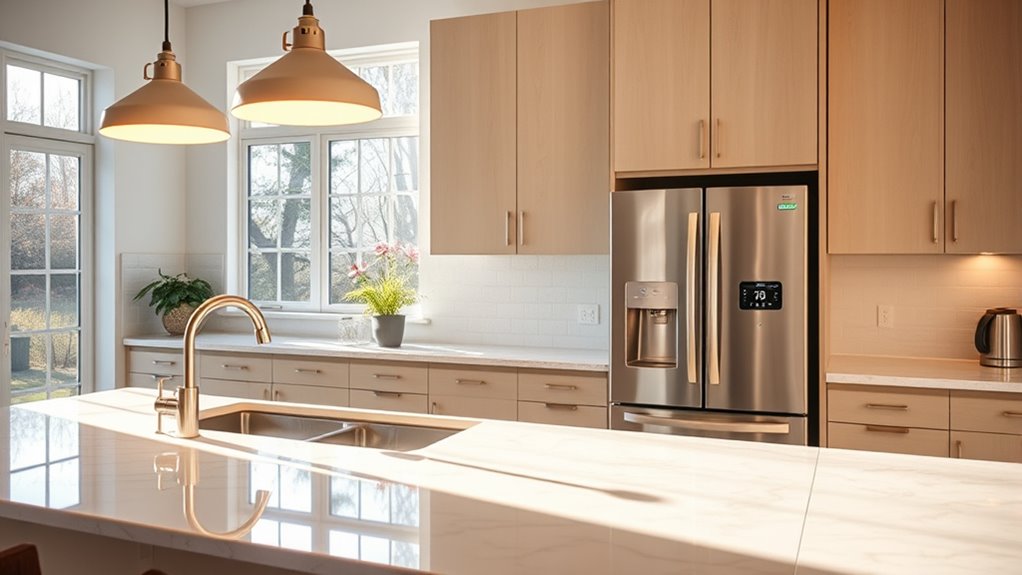
Switching to energy-efficient lighting and appliances is one of the simplest ways to reduce your home’s energy consumption and lower your utility bills. Replace old bulbs with LED bulbs, which use considerably less energy and last longer. LED bulbs provide bright, reliable light and cut down on waste. When shopping for appliances, look for Energy Star certified models—they meet strict efficiency standards and consume less power. These appliances, from refrigerators to washers, can make a noticeable difference over time. Not only do they save money, but they also reduce your carbon footprint. Upgrading your lighting and appliances is an easy, effective step toward a more sustainable home that benefits both your wallet and the environment. Additionally, choosing high-efficiency motors for appliances like HVAC systems can further optimize energy use and enhance overall savings.
Use Eco-Friendly Cleaning Products
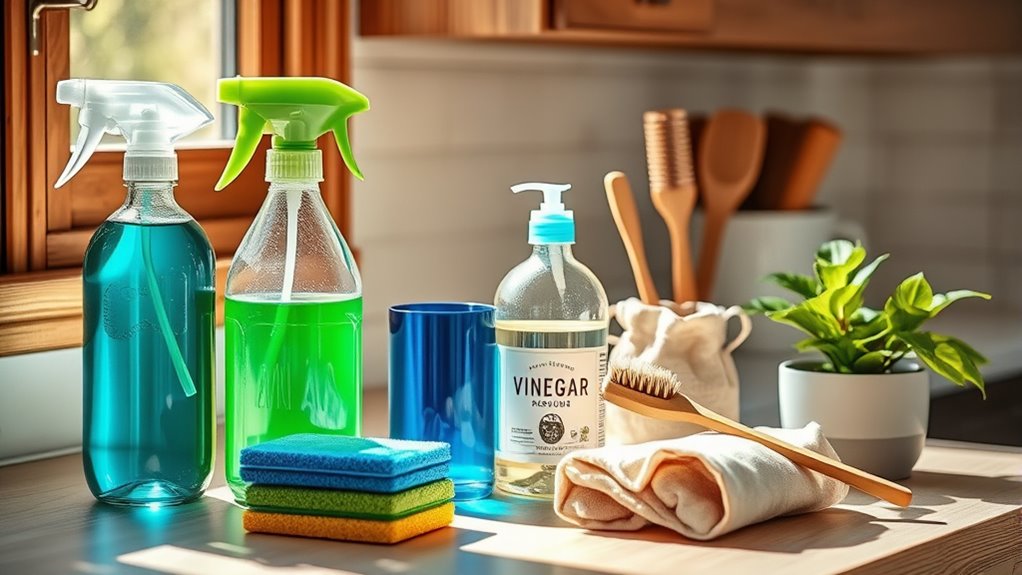
Replacing traditional cleaning products with eco-friendly options is a straightforward way to further reduce your home’s environmental impact. Eco-friendly cleaners often feature biodegradable formulas that break down naturally, minimizing pollution and waste. These products are typically free from harmful chemicals, making them safer for your family and pets. Plus, many use natural scents derived from essential oils, providing fresh, pleasant aromas without synthetic fragrances. Switching to these cleaners doesn’t mean sacrificing effectiveness; many are just as powerful at tackling dirt and grime. By choosing eco-friendly cleaning products, you support sustainable practices and help reduce your carbon footprint. It’s a simple swap that makes a meaningful difference for the environment, your health, and your home’s overall cleanliness. Incorporating plant-based ingredients from gelato and frozen yogurt options can also inspire more eco-conscious choices in your household.
Reduce Water Usage With Smart Fixtures
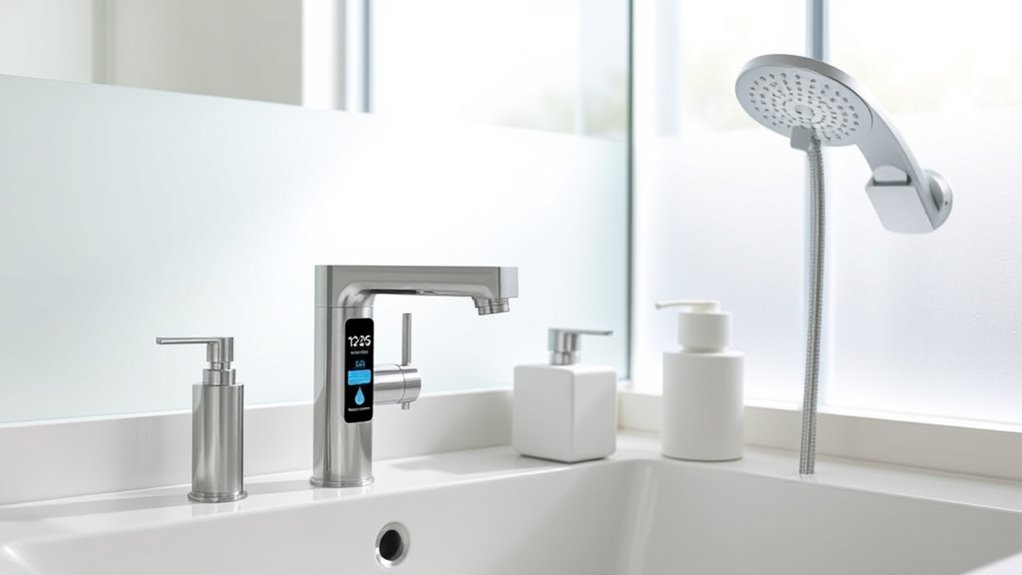
Installing smart fixtures is an effective way to reduce water usage in your home. Water saving showerheads can cut your water consumption markedly without sacrificing performance, helping you save on your utility bills. Leak detection systems alert you immediately to drips or leaks, preventing water waste and potential damage. To maximize efficiency, consider these upgrades:
- Install water saving showerheads to lower flow rates while maintaining comfort.
- Use leak detection systems to identify leaks early and avoid unnoticed water loss.
- Replace outdated fixtures with smart models that automatically shut off or adjust flow based on usage.
- Selecting compatible sprayer tips and accessories ensures optimal performance and minimizes water waste during painting projects.
These smart fixtures not only conserve water but also promote eco-friendly habits, making a big difference in your home’s sustainability.
Choose Sustainable and Minimal Packaging for Groceries

Choosing groceries with sustainable and minimal packaging helps reduce waste and lessen your environmental impact. Look for options wrapped in biodegradable wrappers, which decompose naturally and avoid polluting landfills. Whenever possible, opt for bulk purchasing to cut down on single-use packaging and buy only what you need. Bring your own reusable bags, containers, or jars to stores to eliminate unnecessary packaging. Supporting brands that prioritize minimal packaging encourages industry change and lessens plastic waste. Avoid heavily packaged items and choose products with simple, eco-friendly packaging solutions. Additionally, selecting products with sustainable packaging can further decrease your carbon footprint. By making these small adjustments, you *considerably* reduce plastic waste and support a more sustainable environment. Your mindful choices at the grocery store can make a meaningful difference in reducing overall packaging waste.
Frequently Asked Questions
How Long Does It Take to See Environmental Benefits From These Swaps?
When asking about the timeframe benefits for environmental impact, you can start noticing changes within weeks to months. Switching to eco-friendly products quickly reduces waste and carbon emissions, while energy-efficient choices show benefits in your utility bills and carbon savings within a few billing cycles. Over time, these small swaps accumulate, markedly lowering your overall environmental footprint, making a tangible difference for the planet sooner than you might expect.
Are Eco-Friendly Products More Cost-Effective Over Time?
You might wonder if eco-friendly products save you money long-term. While some believe recycling myths suggest they’re expensive, many eco labels are accurate, showing true cost savings over time. Investing in sustainable options often reduces utility bills and replacement costs. So, yes, eco-friendly products can be more cost-effective, especially when you consider the environmental benefits and potential savings from durable, high-quality items.
Can These Changes Significantly Reduce Household Carbon Footprints?
You might think your small changes don’t matter, but they actually can slash your household carbon footprint dramatically. Switching to renewable energy sources and prioritizing waste reduction can turn your home into a powerful eco-warrior, making a difference way beyond what you imagine. These simple swaps amplify your impact, helping fight climate change faster than you’d believe. Every action you take adds up to a huge environmental win.
What Are the Best Sustainable Brands for Everyday Household Items?
When choosing sustainable brands for everyday household items, focus on those that prioritize recyclable packaging and biodegradable materials. These brands help reduce waste and lessen environmental impact. Look for companies committed to eco-friendly practices, like using recycled content and designing products for easy recycling. By selecting such brands, you actively contribute to a greener future, making a meaningful difference in your household’s sustainability efforts.
How Do I Transition My Family to More Sustainable Habits?
Did you know that involving your family in sustainability efforts increases long-term success? To shift your family to more sustainable habits, start with gradual implementation—introduce simple changes one at a time. Encourage family involvement by making it fun and educational, like planting a garden or reducing plastic use. Over time, these small steps become routine, creating a positive impact and fostering a shared commitment to a greener lifestyle.
Conclusion
By making these simple swaps, you’re planting seeds of change that grow into a greener, healthier world. Each small act is like adding a drop of water to a mighty river—powerful enough to carve new paths toward sustainability. So, take these steps today and watch your efforts ripple outward, transforming your home into a sanctuary of kindness to the planet. Together, your choices can light the way to a brighter, more sustainable future.
